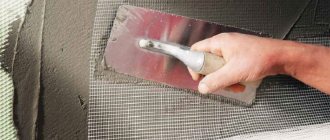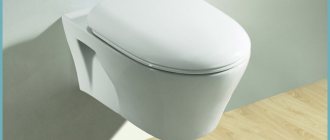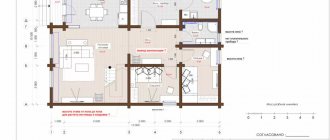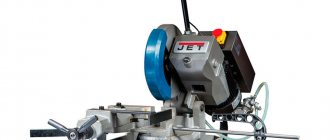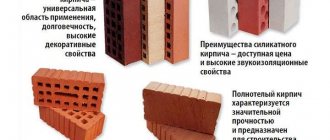When organizing a home, you have to solve a variety of issues, including choosing plumbing. It’s great if the bathtub and toilet are made in the same style. But if choosing a bathtub is quite simple, then when choosing a toilet the question often arises: which toilet is better with an oblique outlet or with a straight one. Release is an important factor in the separation of plumbing fixtures. Depending on the location of the connecting hole, it can be horizontal, vertical or oblique. In this article we will try to talk about the various nuances of choosing plumbing fixtures for a toilet room, and will dwell on the advantages and disadvantages of each type of product.
Outlet - which toilet is better with an oblique outlet or a straight one?
Today there are a huge number of different toilet models on the market, differing in material of manufacture, color, functionality and type of pipe.
The outlet is a drain hole that connects the plumbing to the sewer. The pipe can be positioned in only three directions, and its choice is related to the position of the sewer pipe.
The following types of toilets are distinguished by type of release:
- Plumbing with a vertical pipe
- With horizontal (straight) pipe.
- With oblique connection.
- With universal (vario release).
Important! A double outlet or vario outlet allows for both horizontal and vertical connections of plumbing.
To answer the question of which toilet outlet is better - straight or oblique, it is necessary to evaluate all the advantages and disadvantages of each type.
Horizontal toilet outlet
Plumbing fixtures of this type have been gaining more and more popularity lately. Toilet bowls with a horizontal pipe can be seen in new buildings, since there the sewer system is prudently made for them.
Advantages of the model:
- Easy to install. For a device with a horizontal outlet, the pipe is located at the rear and parallel to the floor. For installation, the plumbing fixture must be pushed tightly against the wall, and the sewer pipe must be connected using a cuff. The toilet is attached to the floor using dowels and bolts.
- Neat appearance.
- Convenient location for repairs and maintenance.
- Variety of designs. There are wall-mounted, floor-mounted and hanging models available for sale. Depending on the size of the toilet room, you can always choose the appropriate option.
Disadvantages of the device:
- If installation is carried out incorrectly, the connection between the pipe and the sewer pipe may not last long.
- The need for a strictly fixed point when connecting, located in a certain place on the floor.
Oblique toilet outlet
Since the times of the Soviet Union, plumbing fixtures with an oblique pipe have been produced. And today our apartments have such plumbing fixtures, so when replacing them, choosing the appropriate option will not be difficult.
The main advantages of the model:
- Reliability.
- Versatility.
- Easy to install.
- Practicality.
- Variety of species.
Toilets with vertical outlet
Models of this type can often be seen in old buildings and private houses. Toilets of this design are connected to a sewer pipe located in the floor. Thanks to this they have many advantages:
- Silence.
- The funnel-shaped bowl prevents water splashing well.
- The pipes are all hidden in the floor and not exposed.
- Aesthetics.
- Variety of models.
- Saving room space.
- Perfect for country houses.
- Possibility of using decorative elements.
The choice between straight and oblique toilet outlet is yours. We hope that after weighing the pros and cons of each type of pipe, you will be able to answer the question for yourself: oblique or direct toilet outlet - which is better? The only advice: select the plumbing outlet based on the location of the existing sewer inlet.
Important! If you choose a plumbing model yourself, and entrust the installation to a specialist, then be sure to consult with him on what type of toilet outlet to choose. Based on the area of the toilet room and the location of the sewer pipes, the technician will tell you which is better - an oblique or horizontal outlet, since connecting the toilet directly depends on its type.
You can install plumbing yourself, if you take into account some of the connection features of each type of outlet. This will be discussed below.
Dismantling old elements
Before connecting the toilet to the sewer pipe, the installation site should be cleared of elements of the previous structures. The procedure is carried out using a hammer, screwdriver and pry bar.
In most cases, the outlet of old products is built into a cast iron structure (“elbow”), which requires breaking the pipe with a hammer. When performing this procedure, be sure to wear safety glasses. Otherwise, sharp ceramic shards will get into your eyes, causing injury.
After the old plumbing fixture is dismantled, you need to knock on all sides of the cast iron pipe, then begin to remove the cement layer and other deposits from the walls.
To remove small parts, a screwdriver and a hammer are enough, but for large elements you will need to use a pry bar. When tapping with a hammer, it is important not to overdo it, because... strong impacts will lead to the splitting of the cast iron socket.
In this case, you will need to break the floor to get to the sewer riser. Then you will need to connect the new outlet to the riser.
When the main deposits have been removed, you can begin the final stage of cleaning the pipeline. To do this, you need to coat them with a special chemical for cleaning the toilet, and then scrape off the residue using a wire brush.
Finish cleaning with a rag. The first 5-6 cm of the cast iron socket must be completely smooth from the inside, because the absence of leaks in the future and the tightness of the joint depend on this. The entire procedure must be carried out wearing protective gloves.
Connecting a toilet with vertical outlet
If, when deciding whether a toilet has an oblique or direct outlet - which is better, you prefer a vertical arrangement, then to connect you will need:
- Special connecting flange with lock.
- Sealant.
Connect the equipment as follows:
- Choose a place to install plumbing equipment based on the rule: the outlet pipe and the sewer inlet must match.
- Mark the location of the plumbing fixtures to prevent future deviations.
- Place the bolts on the flange intended to secure the latrine.
- Install the flange to the sewer outlet.
- Seal the connection to ensure safety.
- Place the toilet on the connecting piece. At the same time, align the pipe with the flange connector as accurately as possible. Use a rubber gasket or caulk to seal the resulting connection.
- Secure the outlet with a special element located on the flange.
- Secure the latrine to the floor and check the tightness of the connections.
Important! Do not use a regular rubber gasket instead of a flange, as attaching a rubber gasket does not achieve the required level of fixation of the plumbing fixtures.
What tools and materials are required
Before connecting the toilet to the sewer, you need to select the necessary building materials and auxiliary tools. The type of fittings used to form connecting parts depends largely on the connection method, product model and desired location.
Basic tools needed for installation:
- silicone;
- corrugation for sewerage;
- hammer, marker, construction tape;
- hacksaw for metal or plastic elements;
- plastic bends and special corners;
- eccentric cuff;
- sealing collar;
- rubber adapters;
- parts required to dismantle the components of the previous connection to the riser and firmly fix the plumbing.
If previously cast iron pipes were used to connect to the sewer system, then most likely you will need professional equipment (a special hammer drill and a grinder).
However, in such a situation, it is advisable not to carry out the dismantling procedure yourself; it is advisable to contact specialists who have the necessary equipment.
Features of choosing a toilet
Progress does not stand still, and manufacturers are constantly offering consumers new types of plumbing fixtures. In order to make a responsible choice and purchase a high-quality model, you need to take into account several criteria at once.
Toilet model
This criterion depends on the area of the toilet room and your preferences. If the bathroom is small, then you can purchase a hanging option. In this case, the entire floor surface will be freed up, and the room will be easy to keep clean.
Important! In addition to hanging options, the market offers floor-standing and wall-mounted models.
Bowl shape
The following bowl shapes are distinguished: round, funnel-shaped, with a shelf (plate-shaped), with a slope. In the model with a funnel-shaped bowl, the drain hole is located in the center. In a design with a slope, the drain hole is shifted to one side.
Important! The option with a shelf is currently used quite rarely, due to numerous disadvantages.
Drain system
The market offers models with continuous drainage of water (single-mode) and models in which drainage occurs in a certain dosage (dual-mode). The latest model allows you to regulate and control water flow as needed.
Type of tank
Based on this feature, the following types of latrines can be distinguished:
- compacts (with detachable tank and cast product);
- toilets with a flush cistern of a hidden installation type;
- hanging tanks.
Models with hanging tanks are used less and less due to their unpopularity. Plumbing fixtures with a concealed-mounted cistern are becoming increasingly popular due to their advantages: compactness (the cistern is mounted in a wall or niche), stronger drainage, and quietness.
Material of manufacture
One of the distinctive features of the equipment is the material of manufacture. Models made from earthenware, porcelain, acrylic, and metal are available for sale:
- Earthenware absorbs moisture quite strongly, which leads to the appearance of small cracks on the surface and a change in the original color.
- Porcelain practically does not retain dirt, however, the cost of porcelain models is much higher. In addition, porcelain does not withstand shock and mechanical damage.
- Acrylic products can be cared for using cleaning products without abrasive particles.
Important! You can also opt for more fashionable and exotic models made of glass and stone.
Anti-splash system
Good toilets with anti-splash.
This system is designed to eliminate splashes from the toilet. The operating principle of this system lies in the special geometry of the drain hole. Often the drain is shifted to one side so that the water column is minimal and splashes are eliminated.
Toilet lid
Models with built-in microlift have appeared on the modern market. This model of lid will not wake up household members with its rattling lowering onto the latrine.
Manufacturer
Pay attention to the models of traditional market “players” - European and American manufacturers. Their products are distinguished by high quality, durability, and reliability. All these characteristics are confirmed by a long-term guarantee.
Classifications of sanitary devices
Progress does not stand still - manufacturers systematically bring new varieties to the market. They can be classified into several groups based on criteria.
Depending on the location of fixation, it is customary to distinguish the following categories:
- Floor-standing.
- Hanging.
Manufacturers also make allowances for the age of their customers and offer:
- Sanitary products for adults.
- Children's options.
The bowl in the equipment may differ in shape:
- Funnel-shaped.
- Rounded.
- Design form (in cases where custom production is acceptable).
The drainage system has differences, and manufacturers have gone as far as possible in this matter. The following options are available:
- Single-mode. When you press the button, the tank is completely emptied.
- Dual mode. You can pour out all the water or only part of it.
- Contactless. Flushing is carried out automatically. This is the most expensive option.
A common question is the availability of side release devices. The reasonableness of such a question occurs only if you have to deal with very small dimensions of the bathroom. The ingenuity of our people is truly limitless, and the side release is proof of this. The thing is that if you place the toilet on its side, you can easily free up the space needed to install a washing machine.
So, such varieties have not yet gone on official sale today, but if you wish, you can literally do everything with your own hands. To ensure lateral descent, adapters can be used. On horizontal sections, you should make a 90-degree turn out of two 45 degrees, although some recommend 90 degrees at once, just to ensure a slope.
Recommendations from experts
If the toilet is located at a distance from the outlet of the riser, make a schematic drawing so as not to make mistakes in the calculations. Special hatches are designed for inspection and clearing of blockages.
A corrugated pipe is installed only in exceptional cases; it is better to use a rigid system, which is assembled with individual elements on site. The drain pipe also works effectively, as it brings the toilet as close as possible to the wall and fits the plumbing fixtures with horizontal and oblique outlets.
It is not recommended to bring the toilet close to the back wall; it is better to leave a few centimeters for ease of maintenance and cleaning. If you plan to cover it with plasterboard, take into account the thickness of the sheets and frame.
The toilet is connected first in line for flushing to a horizontal pipe. If there is another plumbing between it and the drain, the water consumption for flushing will increase, and the drain itself will be slowed down.
If the corrugation has protruding rings at the end, when connecting it, it is placed inside a cut plastic pipe. The corrugation with smooth outer walls at the end fits only with a plastic socket with internal grooves to accommodate the gasket.
Distances
It’s good for those who have a large room allocated for a bathroom or toilet. If yours is not so large, you need to know the minimum tolerances for the distance from the toilet to nearby “structures” and devices.
Distance from the toilet to the wall: according to standards - at least 25 cm
- There should be at least 25 cm between the bidet and the toilet.
- There must be at least 60 cm of free space in front. That is, the distance from the edge of the bowl to the door or wall in front is 60 cm or more.
- There should be at least 25 cm of free space on the sides. This is not enough, but tolerable. Comfortable distance - 35 cm.
Now you draw a plan of your bathroom, mark the minimum distances and see what size toilet will fit into your toilet. So it's simple.
Popular models
Toilet Roca Victoria Nord 342ND7000
Buying a toilet for a toilet where the sewer pipe is located along the wall requires a thorough approach to choosing a model. Size, shape, design features, and appearance are important. Manufacturers who make direct-entry toilets offer traditional and wall-hung models.
The most popular, according to consumers, are toilets of a classic design:
- Roca Victoria Nord 342ND7000;
- VitrA S20 9800B003-7205;
- Jika Era 824532000;
- Cersanit Nature Clean On KO-NTR011-3/5-COn-DL-w;
- Cersanit Street Fusion Clean On KO-SFU011-3/5-COn-S-DL;
- Della Boston OAK.
The price range is from 5 to 18 thousand rubles. Most of them are characterized by the presence of dual flush, a spacious tank, high-quality sanitary porcelain, a comfortable seat, a microlift and an anti-splash system.
Among the suspended models, the leaders are:
- LAUFEN Pro 8.2096.6.000.000.1;
- AM.PM Sense L C741738SC;
- Gustavsberg Hygienic Flush WWC 5G84HR01;
- Cersanit Delfi MZ-DELFI.
The cost of models is from 4 to 15 thousand rubles. Most products do not include a tank, but they do have a microlift and an anti-splash system.
Place of installation of drain tanks and their design
According to the installation method, drain tanks are mounted as follows:
- The drain tanks of the “compact” system are attached to the bowl. This is the most popular option among those used. The advantage is easy access for repairs and compactness.
- In Soviet apartments you can find a hanging cistern. These are already relics of a past era or stylization of the interior for ancient times. The mounting location is the wall above the toilet, which is connected to the bowl-pipe.
- There is also the option of a tank built into the wall, or as it is now called an installation system. Such tanks are usually used with models that do not stand on the floor, but are hung on the wall. At the same time, the tank is most reliably protected in this case.
- And the last, least common - without a cistern. Here the toilet bowl is flushed directly from the water supply system.
The design of the cistern consists of the following elements:
- drain fittings designed to control the discharge of water by shutting off the drain valve. Because of it, there is water in the tank for later draining.
- fittings for water supply, the tank is attached to the water supply system.
- an overflow mechanism that acts as a fuse in the tank system. With continuous supply from the water supply, the mechanism begins to discharge excess moisture.
Installation diagram
Fastening suspended plumbing fixtures is a reason for a separate detailed article. With floor-standing models everything is much simpler. Toilet bowls are placed on special glue (for example, “heavy duty” in yellow tubes) or attached to bolts with holes drilled in the floor. This process is shown schematically below.
To make sanitaryware comfortable to use, the distance to the toilet door must be at least 60 centimeters , the recommended space to the walls is 35 cm .
Requirements according to GOST
Domestic manufacturers of plumbing fixtures develop products in accordance with the requirements of GOST (state standard of the Russian Federation).
Standard dimensions of toilets (hereinafter the dimensions are indicated in the order: length / width / height):
- model with solid cast shelf: 60.5-34 / 36-37 / 40 cm;
- without shelf: 46-34 / 36-37 / 40 cm;
- children's: 40.5 / 29 / 33.5 cm.
There are no strict requirements for the height of the plumbing fixture: it varies from 37 to 39 cm. The narrowest samples are 34 cm, and the shortest ones are 57.5 cm.
Manufacturers develop toilets in accordance with GOST.
Types of connection fittings
For indirect connection or when there is a mismatch between the outlet and inlet to the sewer, connecting elements are used.
- Corrugated pipes. They correct the mismatch of the axes of the connected leads; they are convenient to connect and bend at any angle. Plastic elements stretch and compress as necessary. Thin-walled pipes are more likely to become clogged, and if installed incorrectly, liquid stagnation occurs in them.
- Eccentric cuffs . The adapters look like two branches connected to each other with their axes shifted relative to each other. Used when the sewer socket does not fit with the oblique outlet. This happens when the sewerage system is poorly laid out or when the toilet is replaced with a different design.
- Plastic corners, tees, bends . Used instead of corrugated sections if installation of such is undesirable. Rigidity causes distortions and leaks. The elements are adjusted to length by cutting to size.
Fan pipes are indispensable if there is a risk of the water seal being pulled out of the toilet elbow under pressure. Such a pipe with a built-in valve is installed in the riser or connector. It opens when draining and allows air to normalize pressure.
How to supply water to the tank
A tank is a container that holds water for flushing. Without supplying water pipes to this device, the toilet simply will not be able to perform its main functions - flushing animal products.
Usually, water is supplied to it either from the side or from below. The most common method is the approach from the right or left, that is, the lateral method.
The lower supply is less common, since in this case it is more difficult to attach. But when supplying from below, you cannot hear water entering the tank, which cannot be said about the first method.
Customer Reviews
Nikita, Moscow : “The quality and ease of use justifies the money spent on a hanging model. Beautiful, compact, rimless, hidden installation. It looks stylish, it’s pleasant to use, there’s now a lot of space in the bathroom.”
Vladimir, Moscow : “At this price, an excellent toilet. Almost no tools were required for installation. Before purchasing, I read that the included gaskets for the tank must be changed immediately to prevent it from leaking. That's what I did, and I didn't tighten the fasteners all the way. There are no problems. Disadvantage: the lid must be purchased separately, the toilet seat is modest in size.”
Algorithm for connecting to a sewer pipe
The direction of the model's outlet affects the way the toilet is connected. Despite this, experts talk about general rules for connecting plumbing to the sewer system. They are presented in a small instruction manual:
- the choice of exit is explained by the location of the sewer pipe;
- any connecting element going from the outlet to the inlet of the sewage system (rubber cuff, corrugated pipe, adapter) in diameter should not be less than the toilet outlet pipe;
- when a branch into the sewerage system is laid at a distance, the slope of its pipeline is maintained: 2 cm per linear meter, while the pipe diameter is about 110 mm. Every 100 cm the pipe is strengthened so that there is no sagging;
- the joints are treated with silicone sealant;
- the plumbing outlet does not welcome sharp turns. This will be a place for garbage to accumulate. During installation, special tees are used.
The discharge diagram from the selected installation location of the structure to the inlet to the sewer main will allow you to accurately calculate the necessary parts for connecting the plumbing.
